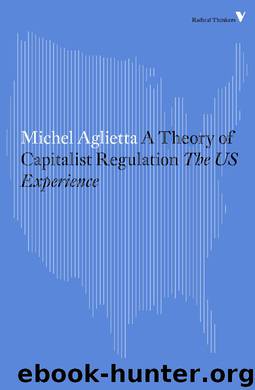A Theory of Capitalist Regulation by Michel Aglietta

Author:Michel Aglietta
Language: eng
Format: epub
Publisher: Verso Books
III. The Forms of Centralization of Capital: The Giant Corporation and the Financial Group
As we have seen, the integrity of an individual capital is dependent on the renewal of a valorization cycle. This does not just ensue spontaneously. The inter-connection and coordination between the different phases in the metamorphoses of value require specific practices of management. The organization of these practices forms a dense network of economic relations, which takes the structural form of the enterprise. The existence of this structure makes it possible to effect a certain partition in the field of economic relations. The interweaving of valorization cycles is not equivalent to an undifferentiated whole. Through the unity it provides, the enterprise protects those practices that are vital for the integrity of the capitalist power of disposal within its boundaries. This is why relations of competition are expressed as external relations between enterprises. All the illusions symbolized in the hypothesis of pure and perfect competition derive from this. The existence of the enterprise, readily apparent to all, is idealized into a subject, an atomic unit without any significant metabolism of its own. This subject is equipped with certain ad hoc behavioural orientations, so that relations of competition can be expressed as an anonymous coordination of decentralized decisions generating a universal harmony. Thereby the real significance of competition is fundamentally obscured, since the relations between enterprises are only scientifically intelligible on the basis of the determinants of their internal functioning: the struggle of capitals for valorization under the constraint of the law of accumulation, deriving from the overall antagonism inherent in the wage relation.
By the profound change it effects in the relations of competition, the centralization of capital also modifies the structural form in which these are expressed. The enterprise is transformed into the giant corporation. The giant corporation is a coherent, autonomous and dynamic structure interiorizing part of the social constraints involved in the valorization of capital. Analysis of this structure must be undertaken from a double standpoint:
(1) The organization that is the structure’s characteristic mode of articulation, in other words the unifying principle of the managerial practices inherent in the valorization of productive capital. This organization should not be posited in an a priori fashion, which would only lead to the abstract and purely logical analysis of its internal relations dear to organizational theorists. It must be understood as the product of constraints determined by the relations of production and exchange, which obviously include first and foremost the antagonism of the wage relation. It is also a response to constraints in the sense of a resolution of contradictions and the search for a coherent set of economic practices. Organization is therefore a structure in motion, on which the transformation of the social conditions of production stamps a law of development.
(2) The planning and control that represent the principle by which the structure functions, and explain how the stability of its organization is ensured, in other words how it is reproduced, and how capitalist ownership is secured. It
Download
This site does not store any files on its server. We only index and link to content provided by other sites. Please contact the content providers to delete copyright contents if any and email us, we'll remove relevant links or contents immediately.
| Anarchism | Communism & Socialism |
| Conservatism & Liberalism | Democracy |
| Fascism | Libertarianism |
| Nationalism | Radicalism |
| Utopian |
The Secret History by Donna Tartt(18951)
The Social Justice Warrior Handbook by Lisa De Pasquale(12170)
Thirteen Reasons Why by Jay Asher(8848)
This Is How You Lose Her by Junot Diaz(6837)
Weapons of Math Destruction by Cathy O'Neil(6220)
Zero to One by Peter Thiel(5736)
Beartown by Fredrik Backman(5682)
The Myth of the Strong Leader by Archie Brown(5461)
The Fire Next Time by James Baldwin(5386)
How Democracies Die by Steven Levitsky & Daniel Ziblatt(5175)
Promise Me, Dad by Joe Biden(5117)
Stone's Rules by Roger Stone(5053)
A Higher Loyalty: Truth, Lies, and Leadership by James Comey(4909)
100 Deadly Skills by Clint Emerson(4882)
Rise and Kill First by Ronen Bergman(4741)
Secrecy World by Jake Bernstein(4703)
The David Icke Guide to the Global Conspiracy (and how to end it) by David Icke(4658)
The Farm by Tom Rob Smith(4468)
The Doomsday Machine by Daniel Ellsberg(4452)
